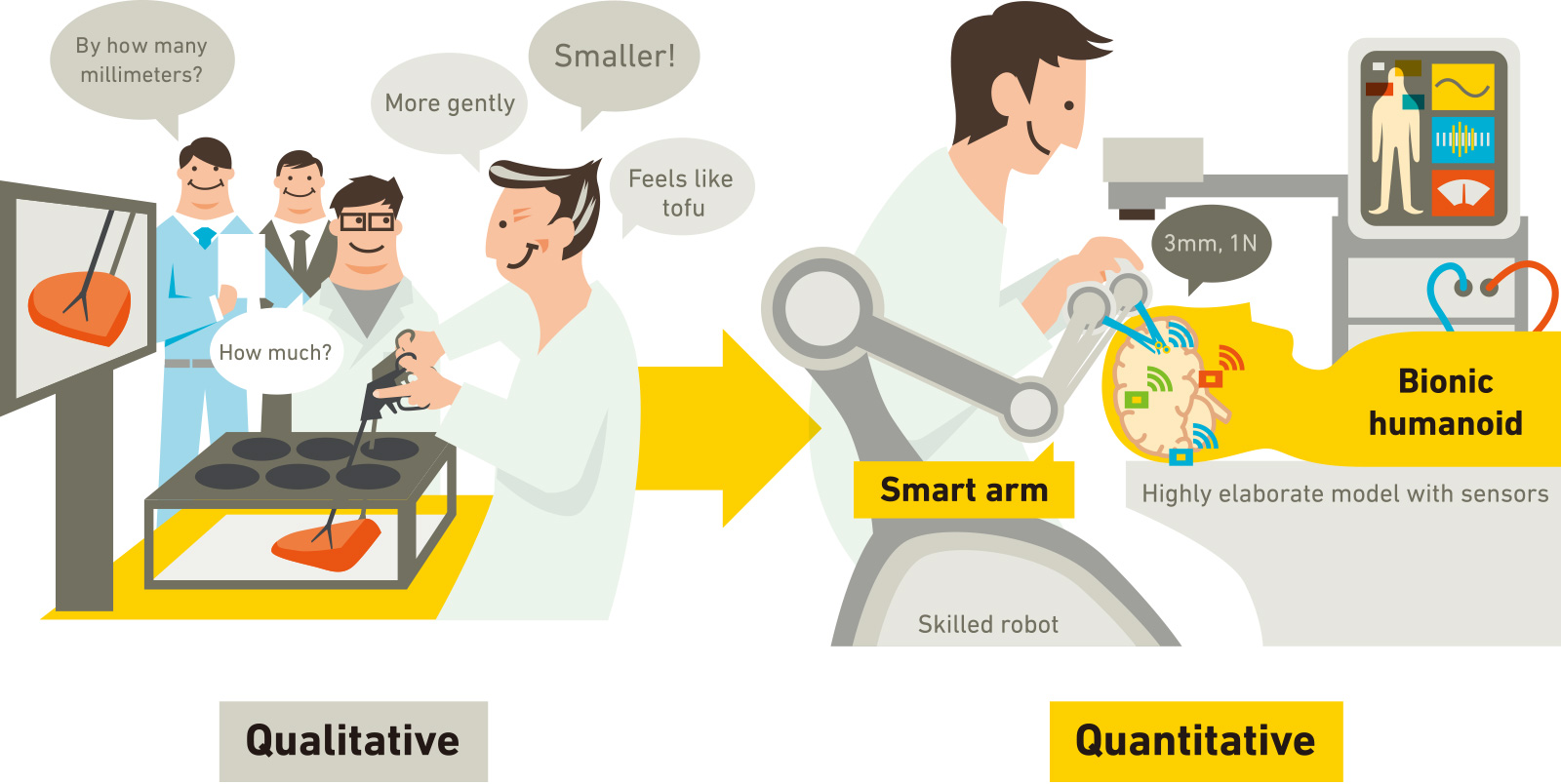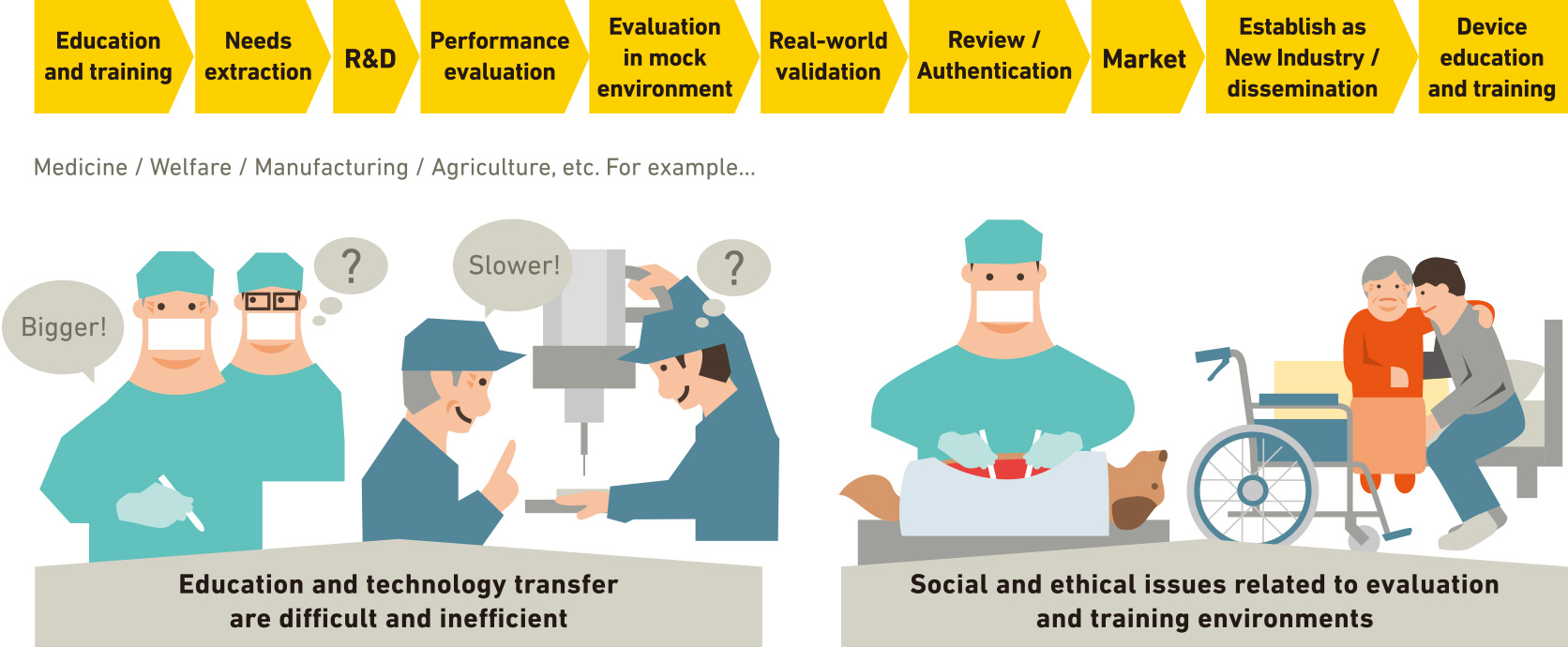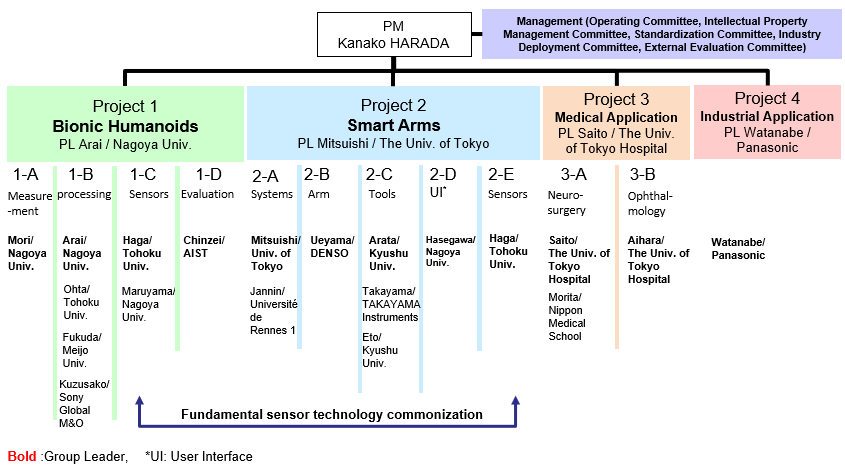
Bionic Humanoids Propelling
New Industrial Revolution
New Industrial Revolution
Program Manager
Kanako Harada
Kanako Harada
2001 Received M.E. from Graduate School, The University of Tokyo
2001‐2004 Hitachi Ltd.
2005‐2007 Japan Association for the Advancement of Medical Equipment
2007 Received Ph. D. in Engineering from Graduate School, Waseda University
2007‐2010 Postdoctoral Research Fellow, Scuola Superiore Sant’Anna, Italy
2010‐2012 Project Assistant Professor, Graduate School of Engineering, The University of Tokyo
2012 ~ Project Lecturer, Graduate School, The University of Tokyo
2015 ~ ImPACT Program Manager
2016 ~ Associate Professor, Graduate School, The University of Tokyo
2001‐2004 Hitachi Ltd.
2005‐2007 Japan Association for the Advancement of Medical Equipment
2007 Received Ph. D. in Engineering from Graduate School, Waseda University
2007‐2010 Postdoctoral Research Fellow, Scuola Superiore Sant’Anna, Italy
2010‐2012 Project Assistant Professor, Graduate School of Engineering, The University of Tokyo
2012 ~ Project Lecturer, Graduate School, The University of Tokyo
2015 ~ ImPACT Program Manager
2016 ~ Associate Professor, Graduate School, The University of Tokyo
Profile
Spanning research experience at universities, industry, hospitals, and abroad, her unique career has also involved work related medical equipment review and standardization. With management experience in international projects concerning machine tools and robots, Prof. Harada aims to return the benefits of research to society at large.
Spanning research experience at universities, industry, hospitals, and abroad, her unique career has also involved work related medical equipment review and standardization. With management experience in international projects concerning machine tools and robots, Prof. Harada aims to return the benefits of research to society at large.
What's New
Overview
Qualitative sensory expressions are used widely in the R&D, evaluation, education, and training in the development of devices for
humans, and significant trial and error is involved. The result is that it takes time for seeds for innovative technology to reach society.
This program proposes to use “elaborate fakes equipped with sensors” to quantitatively understand qualitative sensory expressions
and quickly deliver technology seeds to society by eliminating trial and error. The first target application is the medical field, and we
will develop a bionic humanoid, an elaborate human model equipped with sensors to serve as a substitute for humans and test
animals. This program will also achieve a medical revolution by developing a smart arm using robotic technology seeds to conduct
precision surgeries from small openings. Expanding these results to other industries will lead to a new industrial revolution. 

Disruptive Innovation
Key Points that Become Breakthroughs
Start the challenge in medicine, where the social impact is great
- As a platform that can be used in place of humans and experimental animals:
The Bionic Humanoid as an Elaborate Model of a Human Body Equipped with Sensors
- Deployment of seeds: Skilled robot Smart Arm
- Medical revolution: Ultra-precise treatment through small openings (nose or incisions)
The Challenges for the PM and the Impact of Success
Overview and background
- It takes time for seeds of innovative technology to be brought into actual application and reach the public.
- The process of research and development, evaluation, education, and training for equipment that affects human beings, in particular, involves many qualitative sensory expressions, requires trial and error, and is inefficient.
- By creating an elaborate imitation equipped with sensors that can be used in place of the real thing, qualitative sensory expressions can be understood quantitatively, trial and error can be reduced, and the process can be accelerated. The Bionic Humanoid will be developed as an elaborate model of a human body equipped with sensors, providing a successful example of this concept.
Impact on industry and society in the event of successful achievement
- It will realize quantitative, ethical, efficient research and development, evaluation, education, and training, and it will accelerate innovation.
- The concept and the elements of technology will be widely deployed in industry, bringing about a new industrial revolution.

Scenario for Success and Achievement Targets
Methods of resolution leading to achievement (approach)
- Bring together top world-level researchers in measurements, processing, materials, and robots to break through technical barriers. Pursue prompt collaboration with scientific societies in medicine and medical equipment as well as with standards organizations to overcome time and institutional barriers.
Management strategies
- Set targets that cannot be achieved without close joint research by the participating institutions.
- Technology development that is certain to succeed is assigned to major corporations, while the challenging development is assigned to universities and small to medium-sized enterprises.
Achievement Targets
- Develop a Bionic Humanoid that uses artificial materials to precisely recreate the structure of the head, in particular (membrane of 3-600 μm thickness, etc.).
- Develop a Smart Arm (operates with repeated positioning accuracy of 10 μm and delay of less than 100 ms), conduct simulated surgery with it, and show the possibility of a revolution in medical care.
Risks
- Taking the time risk of standardization and commercialization of results achieved, aggressively promote deployment in industry as elements of technology.
Overall R&D Program Structure Created by the PM
Project 1 Bionic Humanoid
Measure the characteristics of internal organs that are subjects of qualitative sensory expressions, and recreate them using artificial materials with embedded sensors
Project 2 Smart Arm
Using industrial robots arms as a base, develop a safe, intelligent, skilled robot that can be used close to people.
Project 3 Medical applications
Providing samples, etc., evaluating and using prototypes
Projects 4 Industrial applications
Industrial applications

Implementation Structure as Assembled by the PM
Keys of the Implementation Structure
- Close collaboration with engineering researchers, physicians, and corporations.
- Hold management meetings with small numbers of participants, the main participants being the PM, Assistant PMs, and PLs, to conduct fast, flexible decision-making.
Approach to selection of institutions
- Designation without open call: Designate by name those institutions that possess the world's most advanced technology and will provide a powerful driving force.
- Designation by open call: Canvass widely for ideas by open calls regarding new needs, and engage appropriate research institutions.

Organization
The Cabinet Office
ImPACT: Bionic Humanoids Propelling New Industrial Revolution
Kanako Harada
ImPACT: Bionic Humanoids Propelling New Industrial Revolution
Kanako Harada
Associate Program Manager
Masanobu Miyoshi
Masanobu Miyoshi
Associate Program Manager
Yuki Kobayashi
Yuki Kobayashi
Associate Program Manager
Haruhiko Ono
Haruhiko Ono
Associate Program Manager
Masahiro Matsui
Masahiro Matsui
Documents

